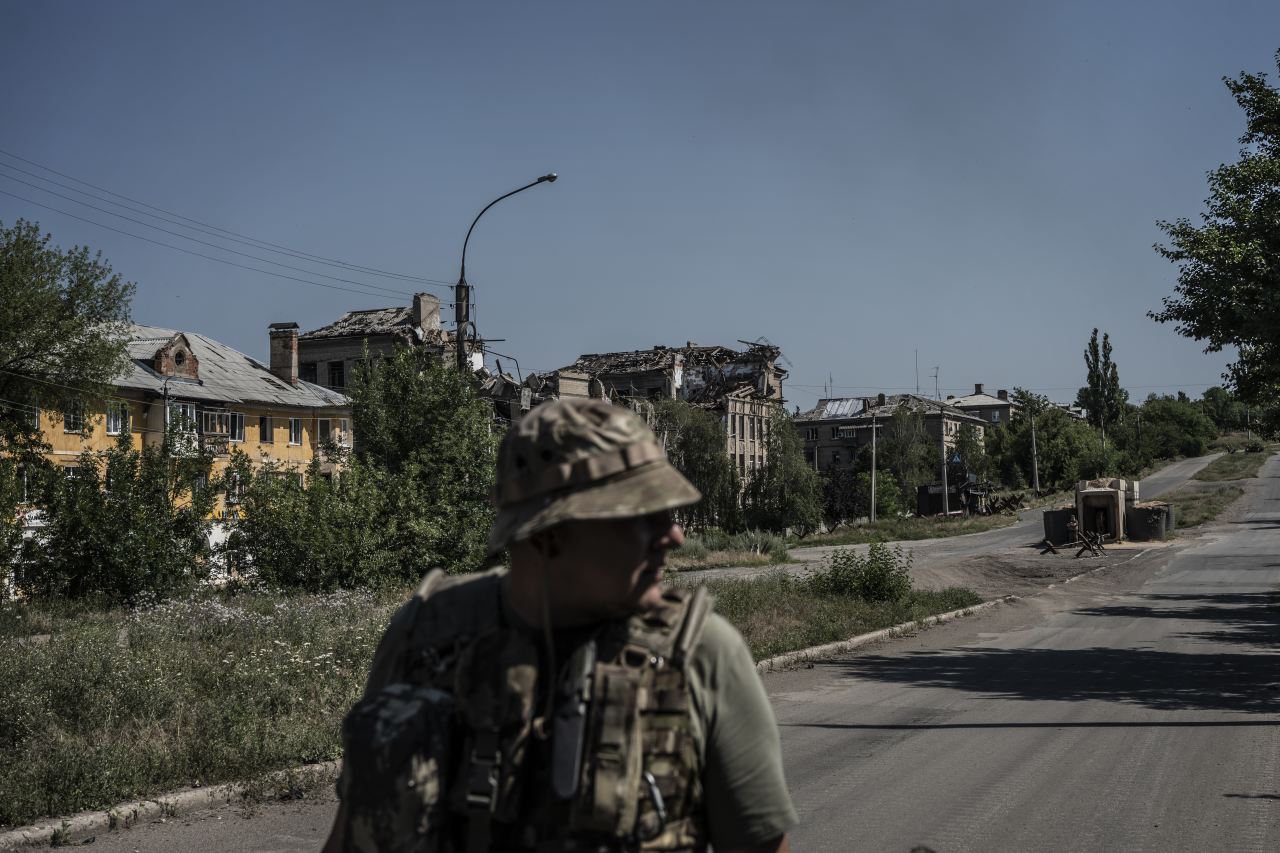The Drone War in Eastern Ukraine
In the sun-drenched eastern front of Ukraine, drones have become a critical component of military operations. From eliminating Russian troops to evacuating wounded soldiers and delivering supplies to foxholes, these unmanned aerial vehicles are reshaping the battlefield. In Kostyantynivka, some infantry from Ukraine’s 93rd Mechanized Brigade have been stuck in their dugouts for months, with rotations delayed due to the need for fog and rain to obscure the view of Russian drones.
Ukrainian air and ground drones now handle essential tasks such as delivering food, water, and ammunition to frontline troops. Lt. Col. Yehor Derevianko, a battalion commander, mentioned that even burgers are being delivered. He has been fighting Russian forces in the east since 2014 and notes that the war is evolving at an unprecedented pace. Drones have become so dominant that they are forcing all other elements of warfare—infantry, armor, artillery, logistics, and even trench design—to adapt to a sky filled with buzzing robots.
Derevianko leads the defense of his sector from a basement full of large screens under an abandoned apartment block. Men with laptops direct drone pilots to where Russian infantry are trying to infiltrate the fields and woodlands around the city. On one screen, the crosshairs of a reconnaissance drone fix on a Russian soldier squatting in a bush. A small quadcopter drone closes in and drops a grenade, which misses. “He’s going to die of old age out there,” grumbles Derevianko. The bush sways gently in the summer breeze. A second grenade turns it into a cloud of gray smoke.
Kostyantynivka, once home to 67,000 people, is a key target of Russia’s summer offensive. Moscow’s invasion forces are inching westward across the fertile Donetsk region, exploiting their numerical advantage but suffering hundreds of assault troops daily for minimal gains. According to Ukraine’s military, drones have surpassed artillery as the leading cause of Russian fatalities.
Drones as the New Battlefield
With the experienced 93rd Brigade holding firm in Kostyantynivka, the Russians are attempting to outflank it via the countryside. Russian infantry must first cross miles of deadly open farmland, often on foot or motorbikes. Most are picked off before reaching Ukrainian lines by first-person-view (FPV) drones—aircraft the size of dinner plates with four rotors, controlled through a live feed on a pilot’s goggles.
Surviving Russians attempt to regroup and assault a Ukrainian trench or dugout. “We have to hit them one by one before they gather,” said Derevianko. The most recent armored attack here was around New Year’s, when 14 Russian armored vehicles tried to run the gantlet of drones. Only two managed to get close, after which defending infantry used rocket-propelled grenades.
However, Russian drones are also tormenting Kostyantynivka. Their fixed-wing Orlan and Zala reconnaissance drones continuously survey the city. Russian FPVs connected to long fiber-optic cables are immune to electronic jamming and can strike anything they see, including civilians.
Outside the command basement, the city is in decline. Only a fraction of its residents remain, and most shops have closed. Airstrikes scar buildings, and orange husks of burned-out civilian cars lie where they were hit by drones. Army vehicles rumble about, covered in grills, nets, and other welded-on drone shields, resembling dystopian fantasies from a Mad Max movie.
Evacuation and Survival Tactics
Pvt. Nikita Kremnov rescues wounded infantry in a Nissan Navara pickup, sprayed a dull green and equipped with a full-body cage and netting. Beyond the city limits, he uses a more nimble quad bike. The last mile to the trenches is now so exposed to Russian fiber-optic drones that the battalion relies on unmanned ground vehicles—drones with tires or tracks—to carry wounded men back from foxholes.
Kremnov was injured by a fiber-optic drone while evacuating a wounded man who was having an epileptic seizure. “There was nothing I could do about it. I had to keep driving.”
Thirty miles southwest, the city of Pokrovsk faces similar challenges. It hasn’t fallen yet, but the damage is extensive. The Russian advance, like slow-moving lava, consumes every town it touches with drones and heavy glide bombs.
A T-72 tank of Ukraine’s 68th Jaeger Brigade hides under the thick summer canopy of a copse outside the city. The unit’s tanks work in shifts, rolling into Pokrovsk to fire at Russian targets from long range. The Soviet-era tank was captured from the Russians early in the war and is affectionately called “Lyalya.” The previous night, it killed a group of Russian infantry with three direct hits on their dugout.
In a drone war, tanks are useful only as mobile artillery pieces, according to the company sergeant, known as Puma. Used in an assault, they wouldn’t even get near the fight, he said. “FPVs are just going to kill us.”
Technological Advancements and Future Threats
In a secret bunker under acacia groves and sunflower fields, men of the Bulava drone unit are developing technology to stay ahead of the Russians in a robotic arms race. Serhiy Ignatukha, the unit’s leader, holds up an FPV armed with four 12-bore shotgun barrels. Recently, one such drone engaged in a dogfight with a Russian FPV, missing with its shotguns but managing to down the enemy drone by ramming it.
The unit is also working with Ukrainian drone manufacturers on more sophisticated solutions, including FPV-borne lasers that can cut fiber-optic cables. FPVs using artificial intelligence could become the next big thing, according to Udav, a drone technician. He held up a drone with a tiny AI chipboard, capable of completing attacks autonomously from up to 700 yards away, even if signals are jammed.
Improved versions of these drones are coming out every few months. “This one is the sixth generation and it has had no failures,” Udav said. “Previously, when you saw 15 Russian vehicles, it was scary. Now it’s fun. Sadly, it’s the same for the enemy’s drone units.”
A bomb maker with the unit used a 3-D printer to make drone-dropped mines. Costing $9 each to make, the mines stick in the ground, spray out several 26-foot-long tripwires with small anchors, and wait for Russian infantry.
The Human Cost of Drone Warfare
East of Kostyantynivka, the Alcatraz Battalion is fighting Russia’s infantry and trying to survive its drones. The unit, part of the 93rd Brigade, is made up of convicted criminals who have signed up to be assault troops. Honorable service can lead to conditional release or pardon. The first missions last year went well, but drones are exacting a growing toll.
Convicted thief Pavlo Shyptenko has survived four attacks by FPVs. He was rescuing a wounded comrade this spring when a quadcopter dropped a grenade on him. A tree branch broke the grenade’s fall, saving Shyptenko, but coin-sized bits of shrapnel still cut into his back and neck. Full of adrenaline, he carried the wounded man to a car and only noticed a terrible pain when he sat down to drive.
Now he advises new recruits on what to do if there’s a drone above them. “Stay still and wait for the grenade drop. Then you have three to five seconds to run away.” If a suicide drone is trying to crash into you, wait and dive out of the way, he said.
The Alcatraz Battalion interviews applicants for suitability and doesn’t take rapists or serial killers. But it has recruited some murderers. “We are also murderers,” said the deputy battalion commander, known as Daredevil. On a balmy evening, men from Alcatraz trained in the woods, practicing digging covered shelters capable of withstanding FPV hits.
“This one is for a funeral,” Daredevil told the diggers of a weakly protected foxhole. Daredevil carries a scar over his right eye from when a Russian shot him in a basement gunfight early in the war. “We came out of that basement. They didn’t.”
It’s a different war today, he said. “The lions from 2022-2023, who were real warriors, no longer exist.” Heavy losses have reduced the quality of soldiers on both sides. “The men now are not capable of the same feats. Now it’s a war of drones.”







